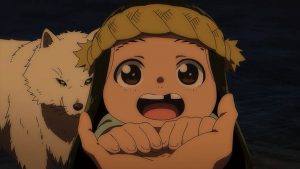 You might be forgiven for thinking that Fumetsu no Anata e is a pretty tragic piece of work. After all it’s delivered two big child death set pieces in the first five episodes, both of which ended in materially the same way (in at least one sense). And to be honest you wouldn’t be totally wrong – this series isn’t exactly sunshine and skittles to be sure. The contrast between permanence and impermanence is very much at the heart of this story, and that’s a subject inherently laden with melancholy. But it ain’t all tears and requiems either (much like existence itself).
You might be forgiven for thinking that Fumetsu no Anata e is a pretty tragic piece of work. After all it’s delivered two big child death set pieces in the first five episodes, both of which ended in materially the same way (in at least one sense). And to be honest you wouldn’t be totally wrong – this series isn’t exactly sunshine and skittles to be sure. The contrast between permanence and impermanence is very much at the heart of this story, and that’s a subject inherently laden with melancholy. But it ain’t all tears and requiems either (much like existence itself).
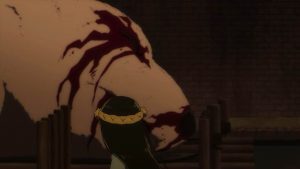 I would probably find myself in the minority in thinking that this arc finale isn’t on a par with the first episode, because both of them seem to be equally beloved by manga fans. My reasoning is pretty simple – what made the story of the boy on the ice so remarkable was how sparingly it was told. The sadness came from the moment, and no effort was expended to sell it. It wasn’t needed. That restraint was missing here, as March’s final moments and their aftermath were presented with an abundance of conventional dramatic flourishes. The first was exceptional and elegantly understated – this was just a well-presented piece of drama.
I would probably find myself in the minority in thinking that this arc finale isn’t on a par with the first episode, because both of them seem to be equally beloved by manga fans. My reasoning is pretty simple – what made the story of the boy on the ice so remarkable was how sparingly it was told. The sadness came from the moment, and no effort was expended to sell it. It wasn’t needed. That restraint was missing here, as March’s final moments and their aftermath were presented with an abundance of conventional dramatic flourishes. The first was exceptional and elegantly understated – this was just a well-presented piece of drama.
 That said, well-presented it was. And I think quite refreshing in the sense that it tells us that To Your Eternity doesn’t have the usual guard rails you’d expect in anime these days. That sense of uncertainty is not only welcome, but I think essential to the series’ formula for success. As I’ve noted, the less conventional Fumetsu is the better it works, and this lack of plot armor is a pretty unusual element. This arc had an unconventional ending presented in very classical fashion. Which is certainly just fine – the substance is there to be sure.
That said, well-presented it was. And I think quite refreshing in the sense that it tells us that To Your Eternity doesn’t have the usual guard rails you’d expect in anime these days. That sense of uncertainty is not only welcome, but I think essential to the series’ formula for success. As I’ve noted, the less conventional Fumetsu is the better it works, and this lack of plot armor is a pretty unusual element. This arc had an unconventional ending presented in very classical fashion. Which is certainly just fine – the substance is there to be sure.
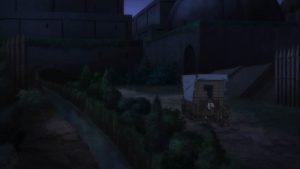 March’s refusal to let Parona carve off a piece of Oniguma to offer as proof to the villagers that it was dead was interesting. But I found her willingness to abide by March’s wishes even more so. If she’s known the truth of Fushi’s existence she wouldn’t have worried about that of course, but Parona is risking a lot by making this decision. Her whole plan is full of risk of course, though certainly the only option realistically available to her apart from playing along with Hayase and remaining in Yanome (which is not really an option at all).
March’s refusal to let Parona carve off a piece of Oniguma to offer as proof to the villagers that it was dead was interesting. But I found her willingness to abide by March’s wishes even more so. If she’s known the truth of Fushi’s existence she wouldn’t have worried about that of course, but Parona is risking a lot by making this decision. Her whole plan is full of risk of course, though certainly the only option realistically available to her apart from playing along with Hayase and remaining in Yanome (which is not really an option at all).
 Honestly, with the constant reminders about March’s obsession with growing up her death was certainly foreshadowed if you believe in flags. It was a spur of the moment decision, one which may or may not have been correct – an adult like Parona would certainly have a better chance of surviving an arrow wound than a young child. The most effecting part of this sequence for me was Parona, in the moments before the arrow, desperately trying to hold things together as it became clear from events just on the edge of shot that they were quickly falling apart. This was a very interesting bit of filmmaking and really heightened the dramatic tension of the moment.
Honestly, with the constant reminders about March’s obsession with growing up her death was certainly foreshadowed if you believe in flags. It was a spur of the moment decision, one which may or may not have been correct – an adult like Parona would certainly have a better chance of surviving an arrow wound than a young child. The most effecting part of this sequence for me was Parona, in the moments before the arrow, desperately trying to hold things together as it became clear from events just on the edge of shot that they were quickly falling apart. This was a very interesting bit of filmmaking and really heightened the dramatic tension of the moment.
 Fushi in Oniguma form is enough of a force to allow escape from Yanome, though the damage has been done of course. The key event here is not March’s death, but Fushi stopping Parona from joining her (implied to be prodded by March). This would have been pretty disrespectful of March’s last act of sacrifice, for starters. But Parona obviously had a task to fulfill, and her life wasn’t hers to throw away in that moment. Fushi is still a relatively minor narrative force (and a totally silent one), but it’s clear he’s growing into his new existence and starting to understand how human emotions are driven.
Fushi in Oniguma form is enough of a force to allow escape from Yanome, though the damage has been done of course. The key event here is not March’s death, but Fushi stopping Parona from joining her (implied to be prodded by March). This would have been pretty disrespectful of March’s last act of sacrifice, for starters. But Parona obviously had a task to fulfill, and her life wasn’t hers to throw away in that moment. Fushi is still a relatively minor narrative force (and a totally silent one), but it’s clear he’s growing into his new existence and starting to understand how human emotions are driven.
 Yanome isn’t giving up on immortality of course, and Parona passed on a chance to finish off Hayase (as opposed to herself). But the story moves on, with Fushi in the company of someone you might have assumed to be a minor figure – Pioran (Aikawa Rikako), the fake shaman and their fellow prisoner. And while his education is certainly a core facet of the story, this is no gently flowing river of contemplation and fleeting relationships on the road. Life, even in this ethereal form, is something that must be treated as precious and protected at all times else it be taken from you.
Yanome isn’t giving up on immortality of course, and Parona passed on a chance to finish off Hayase (as opposed to herself). But the story moves on, with Fushi in the company of someone you might have assumed to be a minor figure – Pioran (Aikawa Rikako), the fake shaman and their fellow prisoner. And while his education is certainly a core facet of the story, this is no gently flowing river of contemplation and fleeting relationships on the road. Life, even in this ethereal form, is something that must be treated as precious and protected at all times else it be taken from you.


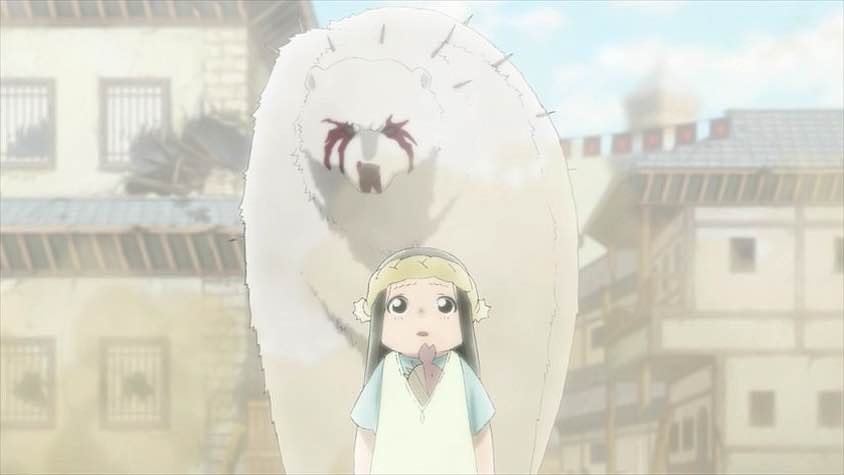

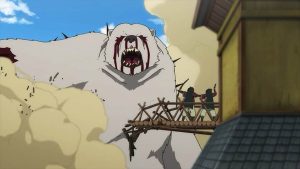
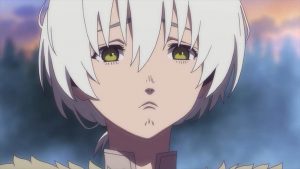


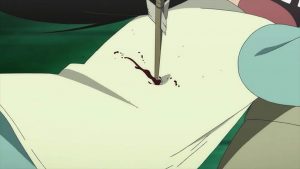

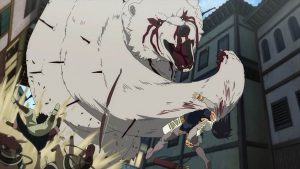
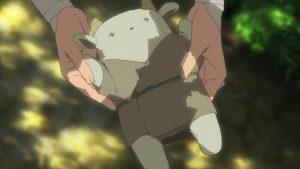
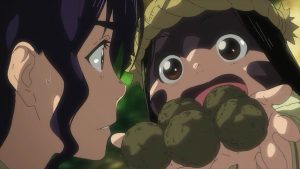
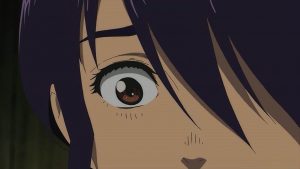

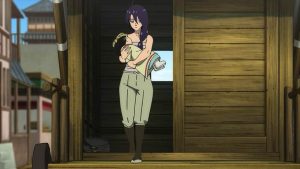
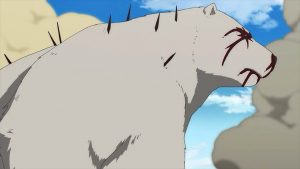




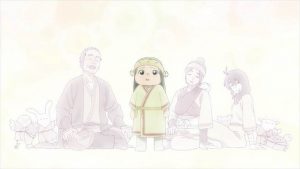
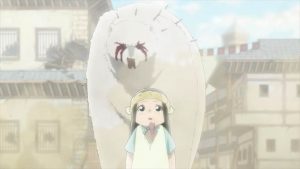
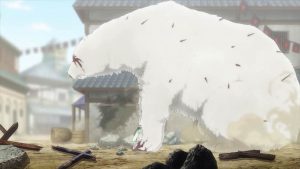
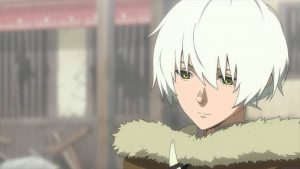
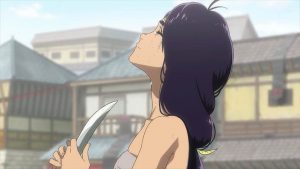
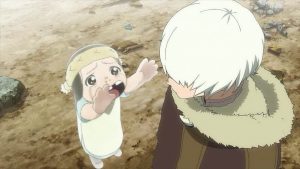
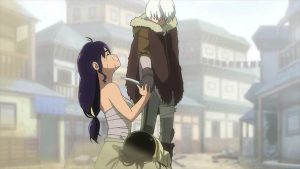

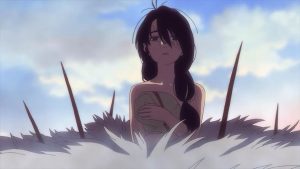
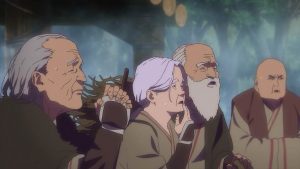
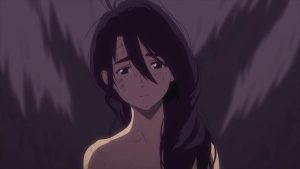
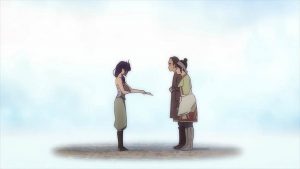
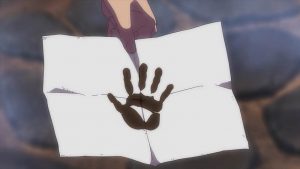

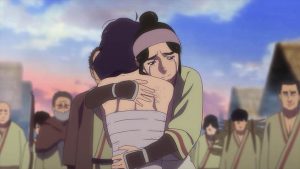
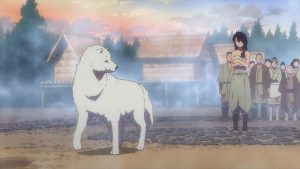
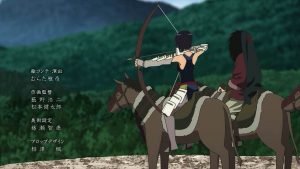

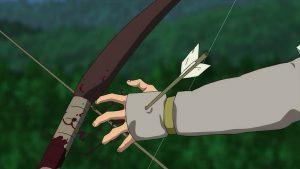

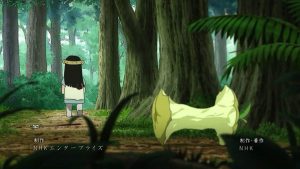


Derrick
May 11, 2021 at 8:23 pmWhen too many shows use “tell, don’t show” then this “show, don’t tell” business felt good.
Although this one might show too much; the first episode was transcendent because some are implied and felt without any big visual cues
Riv
May 11, 2021 at 11:42 pmCompared to the first episode, March’s death didn’t have much emotional impact for me. Parona was my favorite out of this whole arc.
Snowball
May 12, 2021 at 12:09 amI hope it wouldn’t always take a character to die to make me feel emotionally invested in this show, because it would be a bit of a one-trick pony. I thought the boy’s death in episode 1 was very authentic, whereas the conventionality of March’s came off as a tad manipulative and her ghost trying to stop Parona from committing suicide was rather silly. Otherwise, this episode was the best of this arc.
JHNSeph
May 12, 2021 at 4:13 pmI might be in a minority here but I liked March as a character.
An innocent or even naive child with a clear albeit simple dream, that didn’t seem to be fooled by reality.
She didn’t stop being a child but at the same time you could tell she knew goshdarn well what was going and what the stakes were.
I do agree the dramatics following her death were a bit too dialed up compared to episode 1 though. Kinda screamed as if they were really making sure that you are aware of just how sad you should find this. Then again, March imagining herself growing up did hit pretty hard on what never will happen.
Color2413
May 13, 2021 at 5:18 pmI was curiously unmoved by this episode. The tragedy seemed unearned and melodramatic, and March revealed that she could get on my nerves even after shoe turned into a spirit. So far, we have a great first episode followed by fair to good subsequent episodes. I yearn for Fushi to become well enough developed that we are privy to his thoughts and he is no longer an emotional cipher.
Guardian Enzo
May 13, 2021 at 6:30 pmIt’s coming.
DonkeyWan
May 14, 2021 at 1:32 amI dunno, I was gutted by the death of March. Compare it to the countless ‘near death, complete recovery one episode later’ events in Shounen series and it shows the power of a single character with only limited development. Without stakes you cannot become invested in a story. By using the death of a young man and later a small child, the anime demonstrates its understanding of that point. I agree though, the ghostly March undermines that idea somewhat and felt like the anime was drawing its fangs a little.
nixx
May 16, 2021 at 6:08 amWell, this story is tough af.
Krize
May 17, 2021 at 12:25 pmLikewise, I have to admit I didn’t feel particularly stirred by March’s death for the same reasons others have espoused. It may sound harsh, but I’m actually a bit relieved the character won’t be with us for the rest of the series, though this could’ve been accomplished any number of ways (Siimply leaving the arc behind, growing up with a timeskip, etc.). I’m definitely interested in what’s promised by the preview for the next episode given the conventional nature of this arc.
On an aside note, boy, Hayase’s got the survivability of a cockroach. Doesn’t look like she’s playing with a full deck anymore either, though.
Bob
May 18, 2021 at 10:49 amYou’re not alone, I wasn’t particularly impressed with March’s death. Now, Parona’s survival despite failing at everything she set to accomplish, that got me. With all the Ghibli energy she had I felt she’d succeed at just one thing, but nope. Life’s not that easy. It’s also not as cruel as I feared it would be, since March’s parents hugged her when I dreaded a slap. That was well done.
The slow reveal of Hayase’s pursuit was great too; I didn’t realize that that weird black stuff was smoke or that those impacts were arrows/dodging until Parona beat at the fire. When March got shot I just let out a dry chuckle because *of course the kid doesn’t stay safe like they’re told*, but despite the hokeyness of the ghost sequence, March entrusting her feelings to Fushi is ultimately a good thing.
I’m curious how the show will make the old lady engaging.